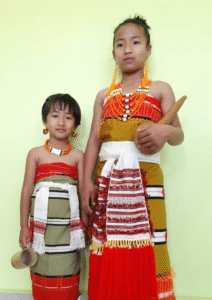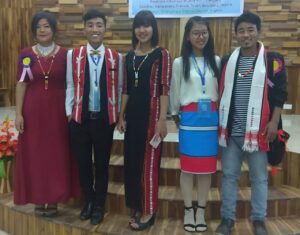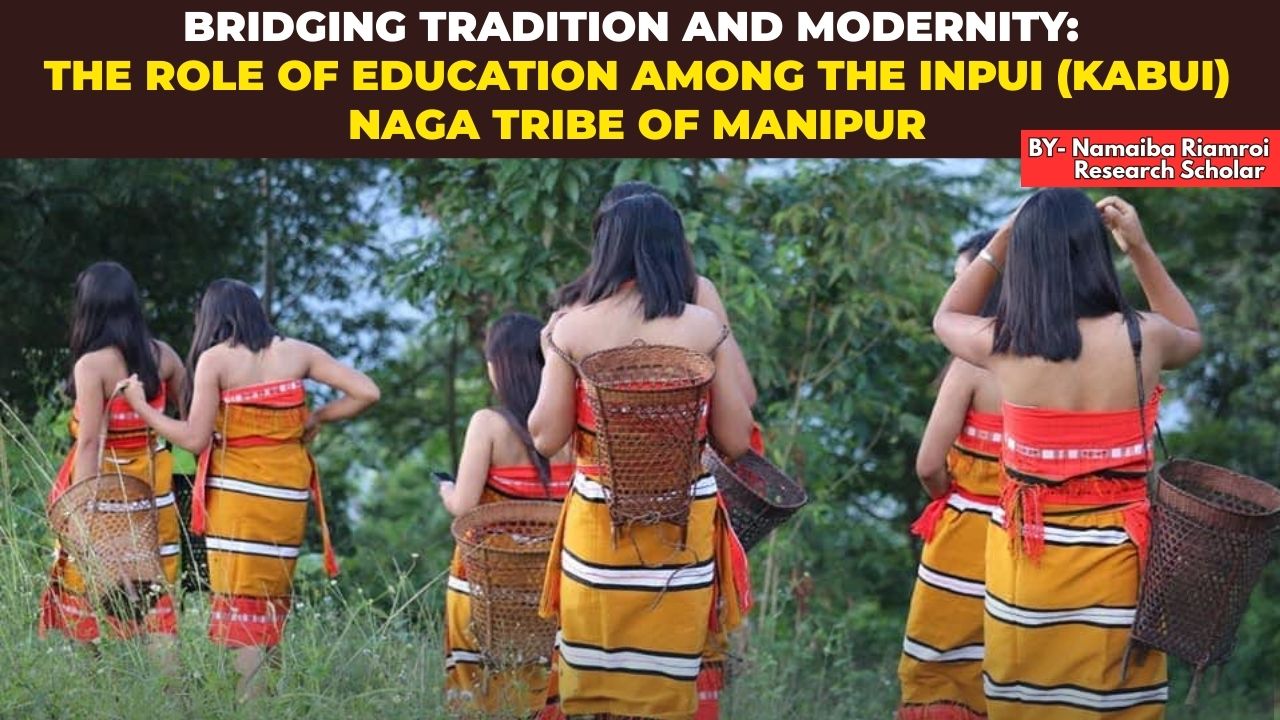Bridging Tradition and Modernity: The Role of Education among the Inpui (Kabui) Naga Tribe of Manipur
(This article is written by Namaiba Riamroi, Research Scholar, Manipur International University)
Abstract
The Inpui (Kabui) Naga tribe of Manipur, a culturally rich indigenous community, has faced growing pressure to adapt to the rapidly changing world shaped by modernization and globalization. This article explores how education has served as a critical agent of transformation among the Inpui, enabling them to bridge the gap between traditional practices and modern expectations. Drawing from historical and contemporary developments, the article analyses how formal education has contributed to cultural preservation, socio-economic upliftment, political awareness, and the integration of indigenous knowledge systems with mainstream pedagogy. It also discusses the challenges posed by modern influences and highlights the community’s efforts to balance continuity and change through culturally responsive educational practices.
Keywords: Inpui Naga, indigenous education, modernization, cultural identity, socio-economic development, Manipur, tribal studies
Introduction
The Inpui (Kabui) Naga tribe, an indigenous group among the Nagas of Manipur, is a community rich in culture, tradition, and history. Living primarily in the Tamenglong, Noney, Imphal West and Senapati districts, the Inpui people have historically maintained a unique identity through their customs, language, festivals, and traditional governance systems. However, like many indigenous communities in Northeast India, they have faced the pressures of modernization and globalization. In this context, education emerges as a crucial force—a bridge linking the traditional way of life with the demands of the modern world. This article explores how education has played a pivotal role in enabling the Inpui tribe to negotiate the delicate balance between preserving their heritage and adapting to modern realities.
Traditional Life of the Inpui Tribe
For centuries, the Inpui tribe lived in self-sufficient villages governed by customary laws and collective decision-making systems, resembling a small republic. Agriculture, particularly jhum (shifting) cultivation, formed the backbone of their economy. Social life revolved around community activities, folklore, oral traditions, and festivals such as Karing-Ngei (which marks the New Year and is central to Inpui identity), Somdungnu, Kutchat Bangei, Nabitnu, Muliangnu, Bangeipui, Tataak and many others were celebrated joyously. Knowledge among the Inpui was traditionally transmitted orally. Elders passed down stories, myths, religious beliefs, agricultural practices, and social norms to the younger generation. This indigenous education was holistic, deeply integrated into daily life, and aimed at maintaining harmony between humans and nature, as well as within the community. However, the traditional system had its limitations. Formal literacy was absent, and opportunities for engagement with the broader world were limited. With the arrival of external influences, particularly Christian missionaries in the 19th century, the Inpui world began to undergo significant changes.

The Introduction of Modern Education
The introduction of Christianity among the Nagas, including the Inpui, brought with it the seeds of formal education. Missionaries established schools where basic reading, writing, and religious studies were taught. Though initially met with resistance, education gradually found acceptance as the community saw its practical benefits. It enabled people to access government jobs, communicate with other communities, and advocate for their rights. In the early years, educational attainment among the Inpui was slow due to geographical isolation, poor infrastructure, rugged terrain and economic hardships. However, as government initiatives to spread education increased in the post-Independence period, more Inpui children began attending schools and colleges. By the late 20th and early 21st centuries, education became a symbol of hope and progress among the Inpui people.
The Role of Education in Bridging Tradition and Modernity
1. Preservation and Revival of Cultural Identity
Contrary to fears that modern education would erase indigenous identities, it has also served as a tool for cultural preservation. Educated Inpui youth, scholars and Inpui organisations like Inpui Naga Union, All Inpui Students’ Union, Inpui Naga Women Union, etc. have taken initiatives to document oral histories, folklore, traditional songs, and customs. Efforts have been made to develop written forms of the Inpui language, producing primers, translations of religious texts, and even dictionaries. Education has given the community the tools to archive their past while adapting to the demands of the present. Young Inpui professionals organize cultural festivals, workshops, and seminars where traditional dances, music, and crafts are taught to new generations, sometimes blending traditional forms with modern aesthetics. Thus, education among the Inpui has not simply led to assimilation into mainstream culture but has facilitated a conscious, critical engagement with their heritage.
2. Socio-Economic Empowerment
Formal education has opened new avenues for socio-economic advancement. Educated Inpui individuals have found employment in government services, education, healthcare, and the private sector. This shift from subsistence agriculture to diversified employment has improved the standard of living for many Inpui families. Moreover, with economic empowerment, there has been a growing investment in community development. Villages have improved infrastructure, better healthcare access, and opportunities for entrepreneurship. Educated youth return to their villages to start schools, health centres, and NGOs, thus giving back to their communities. However, this transition has not been without challenges. The migration of young people to urban centres for education and employment has sometimes led to cultural alienation. Nevertheless, many Inpui youths maintain strong ties with their roots, visiting during festivals and participating in community decision-making.
3. Political Awareness and Advocacy
Education has enhanced political awareness among the Inpui, leading to greater participation in democratic processes. Inpui leaders, armed with formal education and modern political vocabulary, have been able to articulate community demands effectively at state and national levels. The Inpui tribe achieved a significant milestone when they were recognized as a distinct tribe under the Scheduled Tribes Recognition Order in Manipur on 9th January, 2012. This recognition was the result of persistent advocacy, led by educated Inpui leaders who negotiated with government bodies, organized community mobilization, and employed legal mechanisms.
Education has thus empowered the Inpui to navigate the political landscape, safeguard their rights, and claim their place within India’s pluralistic democracy.
4. Challenges of Balancing Tradition and Modernity
While education has brought many benefits, it has also posed new challenges to the Inpui community. The exposure to global cultures, consumerism, and individualistic values has sometimes clashed with traditional communal values. Younger generations, influenced by mainstream media and urban lifestyles, may find traditional practices restrictive or outdated. The use of Inpui language is declining among urbanized youth, posing a threat to linguistic and cultural continuity. Moreover, there is a risk of “rootlessness” among some educated Inpui who, in pursuit of modern success, lose touch with their heritage. The older generation often expresses concern that modernization is leading to the erosion of moral values, weakening social cohesion, and increasing social problems like substance abuse among youth.
5. Strategies for Integrating Tradition and Modernity
Recognizing these challenges, various stakeholders within the Inpui community are working to integrate tradition and modernity through education:
Curriculum Reform: Schools run by the Inpui community are now planning to include local history, language, and culture in their curriculum alongside the national syllabus.
Cultural Institutions: Organizations such as the Inpui Naga Union, All Inpui Students’ Union, Inpui Literature Society, and Inpui Naga Women Union, in collaboration with educated youth and scholars, are organizing cultural education programs for children and youth. They have published some books and are also still on the eve of publishing books related to Inpui history, language, and customs.
Community Events: Cultural festivals like Karing-Ngei have become platforms not only for celebration but also for educating the youth about their roots. The Inpui incorporate traditional activities such as dancing, singing, fire making, rice sorting, playing traditional games, and narrating folktales and folklore, even during events not specifically related to tradition and custom.
Use of Technology: Some initiatives use digital media to document and promote Inpui traditions, making them accessible to younger, tech-savvy generations.
Thus, education is not seen merely as a means of individual advancement but as a communal strategy for cultural survival in the modern world.

Conclusion
The journey of the Inpui Naga Tribe in bridging tradition and modernity through education is a powerful testimony to the resilience and adaptability of indigenous communities. Education has allowed the Inpui to preserve their unique cultural identity, achieve socio-economic mobility, and participate meaningfully in political processes without entirely losing their roots. At the same time, the community remains aware of the challenges that modernization brings. The future of the Inpui tribe depends on their ability to continue developing educational models that integrate traditional knowledge with modern skills, foster a strong sense of identity among the youth, and adapt creatively to changing realities.
In essence, education among the Inpui is not about choosing between tradition and modernity but about weaving them together into a living, evolving tapestry. It is about building a future that honors the past while embracing the possibilities of tomorrow—a future where being Inpui means being proudly rooted yet globally engaged.
References
Abraham, T. M. Handicrafts in India. New Rajender Nagar, New Delhi, 1964..
Barua, S. N. Tribes of Indo-Burma Border: A Socio-Cultural History. Mittal Publications, 1981.
Bhatt, S. C., and Gopal K. Bhargva. Land and People of Indian States and Union Territories. New Delhi, 2006.
Brown, R. Statistical Account of Manipur. 1874.
Dun, Captain E. W. B.S.C. Gazetteer of Manipur. 1886.
Eldwin, Verrier. The Nagas in the Nineteenth Century. Oxford University Press, 1969.
Grierson, George. Language of North Eastern India. Vol. II, Gyan Publishing House, 2000.
Hodson, T. C. The Naga Tribes of Manipur. 1911.
Kamei, Gangmumei. History of Manipur: Pre-Colonial Period. 2015.
Kamei, Gangmumei. A History of Modern Manipur: 1826–2000. 2016.
Khumba, Agak. Inpui Lungh (Living of the Inpui), 2023
Khumba, K. Alung. The Inpui Nagas: Traditional Culture and Christianity.
Khumba, K. Hibou. The Cultural Influence of the Inpui (Kabui) Naga on the Church.
Khumba, Namphurei. The Inpui Naga Traditional Festivals and Their Implications.
McCulloch, Colonel. Account on the Valley of Manipur and the Surrounding Hills. 1874.
Mina Devi, Thouchom. The Ethnological Study of the Liangmei Tribe of Manipur. 2016.
Pemberton, R. B. The Eastern Frontier of India. Mittal Publications, 1835.
Riamroi, Banimthoi. Souvenir—Golden Jubilee Celebration, Oktan (Puichi). 1999.

